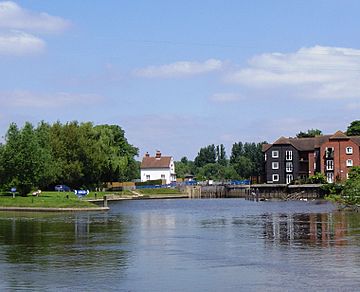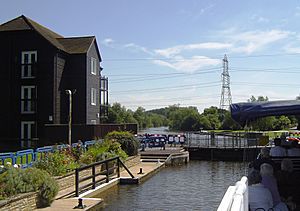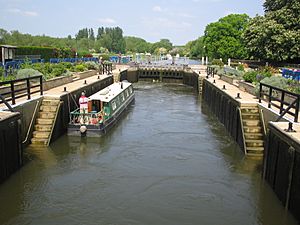Sandford Lock facts for kids

Approaching Sandford Lock from downstream
|
|
| Waterway | River Thames |
|---|---|
| County | Oxfordshire |
| Maintained by | Environment Agency |
| Operation | Hydraulic |
| First built | 1631 |
| Latest built | 1973 |
| Length | 53.03 m (174 ft 0 in) |
| Width | 6.62 m (21 ft 9 in) |
| Fall | 2.69 m (8 ft 10 in) |
| Above sea level | 176' |
| Distance to Teddington Lock |
89 miles |
| Coordinates | 51°42′29″N 1°13′59″W / 51.708048°N 1.233104°W |
| Power is available out of hours | |
Sandford Lock is a special kind of lock on the River Thames in England. It is located at Sandford-on-Thames, which is just south of Oxford. This lock is known for having the deepest "fall" (the height difference it lifts or lowers boats) of all the locks on the Thames, at about 2.69 meters (8 feet 9 inches).
The lock is connected to a large island, one of three islands in this part of the river. You can find the lock at the end of Church Lane in Sandford on Thames. Upstream from the lock, there's a main weir (a small dam) that connects another island to the opposite bank near Kennington, Oxfordshire. This area is home to the Sandford Lasher, a powerful weirpool.
Contents
History of Sandford Lock
There has been a lot of activity at this spot for hundreds of years. Around 1294, the Knights Templar built a mill here. Records also show that there was a ferry and a place to catch fish in the Middle Ages.
Early Conflicts and Locks
In the time of King Edward III, there were arguments between mill owners and people who used barges on the river. At one point, "the men of Oxon" (people from Oxford) broke down the locks at Sandford. This was probably at an older type of lock called a "flash lock" on a river channel behind the second island. In 1631, the Oxford-Burcot Commission built one of the first "pound locks" in England right here. A pound lock is a much more controlled way to move boats up and down the river.
Changes Over Time
The lock was later taken over by the Thames Navigation Commission in 1790. It was made longer in 1795 by Daniel Harris, who was the gaoler (jailer) in Oxford. This work cost nearly £1,800. In 1836, a brand new lock was built next to the old one, where the current lock stands today. A lock house for the lock keeper was built in 1839. The old lock was later filled in after an incident where a mill owner opened the water gates and caused damage. You can still see where the old lock was, especially the top gates, in the stonework above the current upper gates. An iron bridge was built above the lock between 1866 and 1877. The most recent time the lock was rebuilt was in 1972.
Sandford Lasher: A Powerful Weir
The Sandford Lasher, also known as a weir, is located on the left bank of the river, a bit upstream from Sandford Lock. The water below this weir has been known for its strong currents since the 1800s. Weirs, like the one at Sandford Lasher, create very powerful currents. These currents can be dangerous because they can trap objects and people underwater at the bottom of the structure.
Memorial at the Lasher
Near the weir, there is an obelisk (a tall, four-sided stone pillar) from the 19th century. This obelisk remembers five students from Christ Church, Oxford who sadly drowned there.
River Section Above the Lock
After the third island, which is called Fiddler's Elbow, the river makes a sharp turn at Rose Isle. On the west bank of the river, you'll find the town of Kennington, Oxfordshire. Further upstream, you'll see the Kennington Railway Bridge, where the Hinksey Stream flows back into the River Thames. You'll also find the Isis Bridge, which carries the Oxford southern bypass road.
The Thames Path, a walking trail, follows the western bank of the river. It goes all the way to Iffley Lock, crossing the Hinksey Stream on the Kennington Towpath bridge.
Generating Electricity with Water Power
Work began in 2011 to build a hydroelectric power system at Sandford Lock. This system uses three large Archimedes screws to generate electricity from the flowing water. These screws started working in 2018, turning the river's power into clean energy.
Sandford Lock in Books and Media
The Sandford Lasher and its dangers are mentioned in several famous books.
Three Men in a Boat
In chapter 18 of Three Men in a Boat (1889) by Jerome K. Jerome, the author describes the pool under Sandford Lasher:
The pool under Sandford lasher, just behind the lock, is a very good place to drown yourself in. The undercurrent is terribly strong, and if you once get down into it you are all right. An obelisk marks the spot where two men have already been drowned, while bathing there; and the steps of the obelisk are generally used as a diving-board by young men now who wish to see if the place really IS dangerous.
Jerome was a close friend of J.M. Barrie, who wrote Peter Pan. He likely knew Michael Llewelyn Davies, one of the boys who inspired Peter Pan.
Other Mentions
The lock is also mentioned in The Dictionary of the Thames by Charles Dickens, Jr., the son of the famous author. He wrote about how well-known the Sandford Lasher was for its dangers.
In Tom Brown at Oxford, a book by Thomas Hughes first published in 1861, the main character, Tom Brown, has a close call. He accidentally rows his boat over the weir and into the powerful lasher. Sandford Lock is also briefly mentioned in The Four Feathers by A.E.W. Mason (1902). It even appears briefly in the poem The Burden of Itys by Oscar Wilde.




